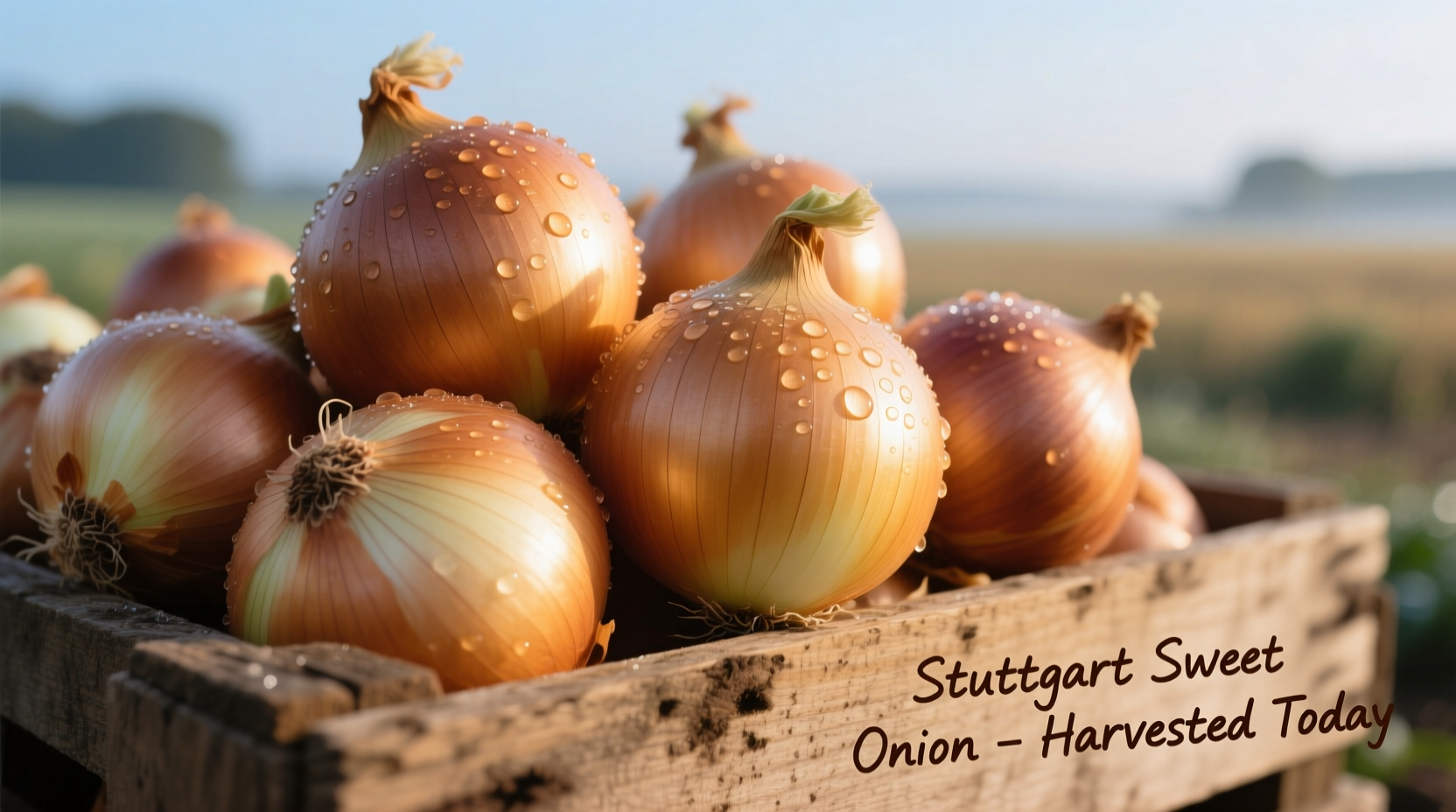When you're searching for the perfect onion for fresh salads, sandwiches, or raw applications, the Stuttgart Sweet stands apart from ordinary yellow onions. This distinctive variety delivers culinary versatility without the harsh bite that often accompanies standard storage onions. Gardeners appreciate its reliable bulb formation and adaptability to southern climates, while chefs value its consistent sweetness that enhances dishes without overwhelming other ingredients.
Understanding the Stuttgart Sweet Onion's Origins
Despite its German-sounding name, the Stuttgart Sweet onion traces its development to Stuttgart, Arkansas—a small agricultural community in the Mississippi Delta region. Agricultural researchers at the University of Arkansas began cultivating this variety in the early 1950s, selecting it from Texas Grano 502 stock for superior sweetness and storage characteristics. By 1953, it was officially released as "Stuttgart Riesen" (German for "Stuttgart Giant") to reflect both its place of origin and impressive size potential.
Development Timeline of the Stuttgart Sweet Onion
- 1948-1950: Initial crossbreeding begins at Arkansas agricultural research stations
- 1951: Promising bulb characteristics identified in experimental plots
- 1953: Official release as "Stuttgart Riesen" for commercial cultivation
- 1960s: Becomes dominant yellow onion variety in southern United States
- Present: Remains a preferred variety for spring harvest and fresh market sales
Distinctive Characteristics Compared to Other Varieties
What truly sets the Stuttgart Sweet apart is its chemical composition. With pyruvate levels measuring between 0.08-0.12 (compared to 0.15-0.20 in standard yellow onions), it delivers noticeably less pungency. This biochemical difference translates to real-world culinary advantages when preparing dishes that feature raw onions.
| Onion Variety | Shape | Season | Sweetness Level | Best Uses |
|---|---|---|---|---|
| Stuttgart Sweet | Flat globe | Spring (Mar-May) | ★★★★☆ | Raw applications, sandwiches, salads |
| Vidalia | Rounded | Spring (Apr-Jun) | ★★★★★ | Raw consumption, caramelizing |
| Yellow Storage | Rounded | Fall-Winter | ★☆☆☆☆ | Cooking, soups, stews |
| Red Onion | Round | Summer | ★★★☆☆ | Garnishes, salads, pickling |
Optimal Growing Conditions and Harvesting
Stuttgart Sweet onions thrive in USDA hardiness zones 7-9, particularly in regions with mild winters and warm springs. They require well-drained, sandy loam soil with a pH between 6.0-6.8. Unlike many storage onions, they're day-length sensitive, forming bulbs when daylight reaches 12-14 hours. This makes them ideal for southern climates where spring days lengthen gradually.
Harvest timing proves critical for maximizing sweetness. The optimal window arrives when approximately 50% of the tops have naturally fallen over, typically in late April through May depending on planting date. Harvesting too early yields underdeveloped bulbs with poor storage capability, while waiting too long risks neck rot and reduced shelf life. After harvesting, proper curing requires 7-10 days in a well-ventilated area with temperatures around 75-80°F (24-27°C) and humidity at 70-80%.

Culinary Applications and Flavor Pairings
The Stuttgart Sweet's mild flavor profile makes it exceptionally versatile in the kitchen. Unlike stronger onion varieties that can dominate a dish, this variety provides subtle sweetness that complements rather than competes with other ingredients. When sliced paper-thin for sandwiches or burgers, it delivers flavor without the harsh aftertaste common in standard yellow onions.
Professional chefs particularly value Stuttgart Sweets for:
- Raw applications where onion flavor should enhance without overpowering
- Quick-pickling for relishes and condiments
- Grilling whole where caramelization brings out natural sugars
- Fresh salsas and pico de gallo
- Lightly sautéed for quiches and frittatas
For best results, use within 2-3 weeks of purchase as their thin skin makes them less suitable for long-term storage compared to storage onion varieties. Keep them in a cool, dark place with good air circulation—never refrigerate whole onions as moisture accelerates spoilage.
Practical Selection and Storage Tips
When selecting Stuttgart Sweet onions at the market, look for firm bulbs with dry, papery skins free from soft spots or mold. The neck should be completely dry and closed—avoid any with green sprouts emerging. Heavier onions for their size typically indicate higher moisture content and better freshness.
Understanding the limitations of this variety proves equally important. While excellent for fresh eating, Stuttgart Sweets lack the storage capability of traditional yellow onions. Their high water content (88-90%) and thin skin make them prone to sprouting after 3-4 weeks under typical kitchen conditions. For dishes requiring long cooking times or extended storage, consider blending with a small portion of storage onions to maintain structural integrity while preserving sweetness.











 浙公网安备
33010002000092号
浙公网安备
33010002000092号 浙B2-20120091-4
浙B2-20120091-4